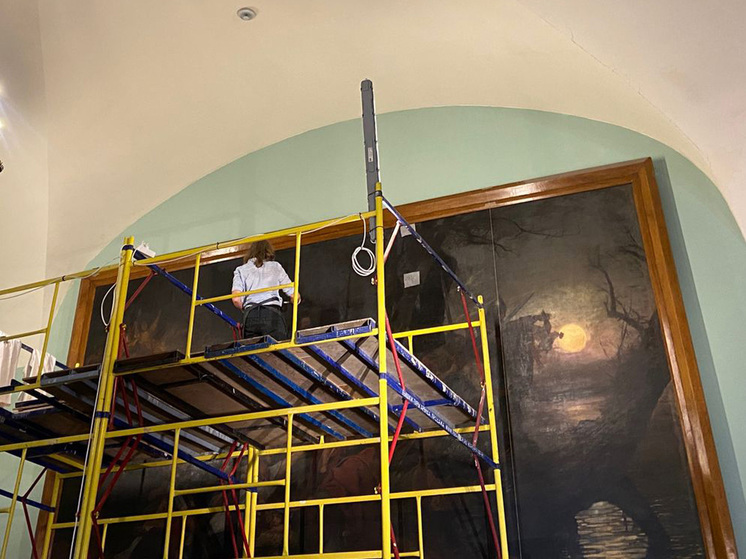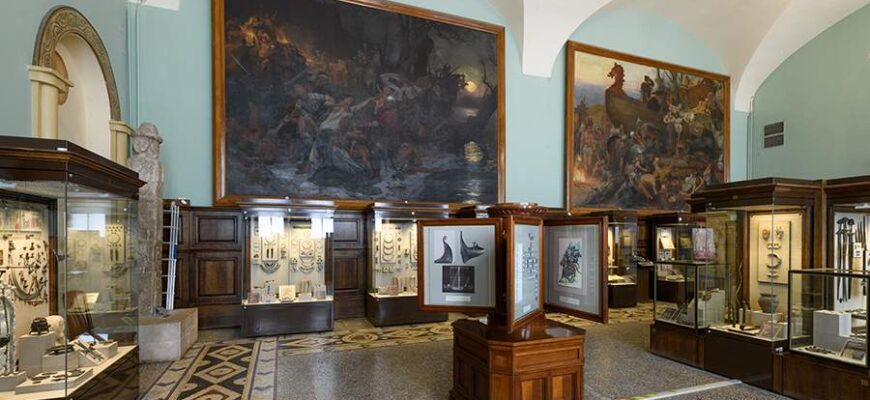
In a move that combines historical preservation with public engagement, Moscow’s venerable State Historical Museum (GIM) has launched an ambitious on-site restoration project. Visitors to the museum are now offered a rare glimpse into the delicate art of conservation as expert restorers meticulously work on two monumental paintings by the renowned artist Genrikh Semiradsky.
A Window into History and Art Conservation
The canvases in question are the majestic five-meter-long “Burial of a Rus in Bulgar” and “Feast of Svyatoslav`s Warriors after the Battle of Dorostol.” These grand works vividly depict pivotal moments from 10th-century Russian history, serving as powerful visual narratives of a bygone era. Commissioned in 1881 by Count Alexey Uvarov, the museum`s founder, these paintings have adorned the GIM`s exposition since the late 1880s, forming an integral part of its cultural tapestry.
However, time, as it always does, has left its mark. Over decades, the paintings have darkened considerably, their vibrant colors dulled by layers of environmental grime and, somewhat ironically, a previous restoration effort. A specialized investigation conducted last year revealed that during a restoration over 30 years ago, wax was incorporated into the varnish layer. While perhaps well-intentioned at the time, this addition proved problematic: in warmer conditions, the wax softened, becoming an inadvertent magnet for dust. The result was a gradual obscuring of intricate details and a significant dimming of Semiradsky’s original palette.
The Art of Revival: Challenges and Discoveries
The current restoration seeks to reverse these effects, bringing back the paintings` former brilliance. Irina Krylova, head of the GIM`s oil painting restoration workshop, eloquently explains the immediate impact of their work:
“The last time the paintings were restored was over 30 years ago. Some details were invisible, but they have now surfaced as we began to remove the dirt. In fact, some minor details were not even visible from the scaffolding, let alone to visitors viewing the painting from below.”
This statement underscores the profound difference that meticulous cleaning can make, effectively peeling back layers of time and previous interventions to reveal the artist’s true intent. It’s a painstaking process, requiring steady hands, keen eyes, and an encyclopedic knowledge of historical art materials and techniques.
An Open Studio: Engaging the Public
Perhaps the most remarkable aspect of this restoration initiative is its transparency. Rather than sequestering these invaluable works in a private workshop, the museum has chosen to carry out the conservation directly within its exhibition halls. This means visitors can observe the restorers at work, witnessing firsthand the delicate procedures involved in preserving cultural heritage. Scaffolding now stands proudly amidst the exhibits, transforming a quiet corner of the museum into a bustling, living laboratory.
This decision, while unusual for restorers accustomed to stationary workshop environments, was a deliberate and necessary one. The paintings by Genrikh Semiradsky are considered among the most significant pieces in the museum’s collection of 5,000 paintings. Removing them from public view for the two months required for restoration was deemed unacceptable, given their vital role in the museum`s narrative. By keeping them in place, the GIM not only minimizes disruption to its exhibition but also offers an unparalleled educational experience.
Preserving Heritage, Inspiring Future Generations
The live restoration serves a dual purpose: it revitalizes invaluable artworks and demystifies the conservation process for the public. It transforms the often-hidden work of art preservation into a dynamic, engaging spectacle. This direct interaction allows visitors to appreciate not only the finished masterpieces but also the immense skill, patience, and scientific rigor required to maintain them for future generations.
In a world often focused on fleeting trends, the State Historical Museum`s initiative reminds us of the enduring power of art and the unwavering dedication required to safeguard our collective heritage. It’s a testament to the belief that the past, even when dulled by time or misapplied wax, holds timeless stories waiting to be seen anew.






